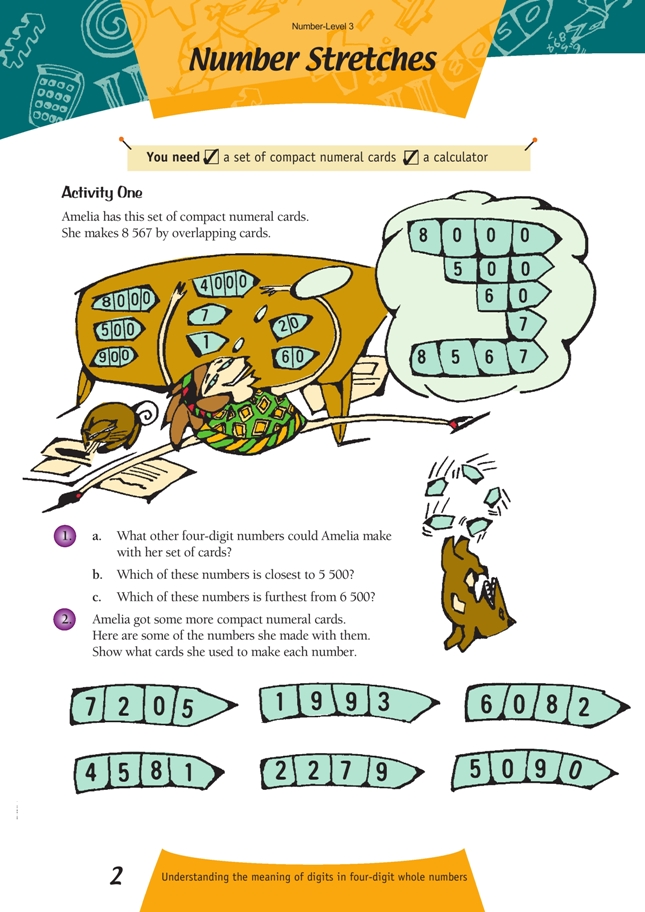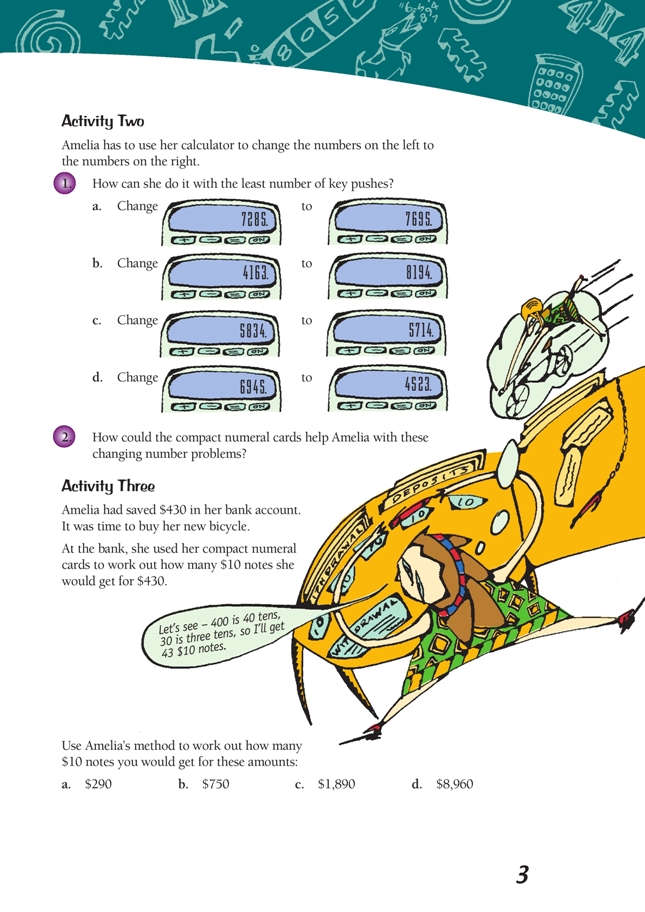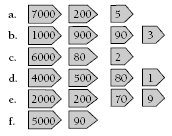This is a level 3 number activity from the Figure It Out series. It relates to Stage 6 of the Number Framework.
A PDF of the student activity is included.
Click on the image to enlarge it. Click again to close. Download PDF (227 KB)
show an understanding of place value for 4 digit numbers
FIO, Level 3, Number, Book 1, Number Stretches, pages 2-3
Calculator
Activity One
This activity helps develop understanding of the meaning of digits in four-digit whole numbers. There is a copymaster of Amelia’s set of compact numeral cards at the back of this booklet.
The arrows on the right of each card help students align the cards correctly because they are arranged with the ones numeral card on top through to the thousands numeral card on the bottom.
Question 1a is a challenging investigation if students are going to find all the possibilities. You may wish to let students work by themselves or in pairs to see how many four-digit numbers they can find in 5 minutes and then bring all the students together to discuss their findings and the strategies they used. Highlight the need for a strategic approach. If they need help, you could suggest:
“If you work out all those numbers that use the 8 000 card, how can you use this list of numbers to easily find the numbers for the 4 000 card?”
“Have you tried recording all the possible numbers from the largest to the smallest?”
“If you know the four-digit numbers that use the 8 000 and the 500 cards, how can you use this list of numbers to make all the numbers with the 8 000 and the 900 cards?”
These sorts of prompts may help students find the 54 possible four-digit numbers that can be made with the set of cards if you include all the ways of using zero.
The question asks “What other four-digit numbers ...”, so they will have to exclude the number 8 567, which will leave 53 different four-digit numbers.
Questions 1b and 1c are ideal for exploring the students’ mental thinking strategies if, once they have decided on an answer in their heads, you ask them: “How do you know?” or “How many different ways did we use to find the solution?”
In question 1b, the solution will clearly have to be the biggest possible number that can be made using the 4 000 card. This will be 4 967.
Question 1c compares the difference between 8 967 and 6 500 with the difference between 4 000 and 6 500.
Question 2 could be used as a good assessment task to find out whether the students have grasped the objective of the activity (understanding the meaning of digits in four-digit whole numbers).
Activity Two
You may have to tell students that they cannot use the cancel button on the calculator.
For students having difficulty with question 1a, use the compact numeral cards as suggested in question 2. The students could make 7 285 with compact numeral cards and then work out which cards would need to change and by how much. They should find that the 200 card will need to become 600 and the 80 card will need to become 90, which is a total increase of 410. Ask students which buttons they should press on the calculator to increase the total by 410. They could then continue with the rest of question 1.
Activity Three
If students come up with a quick method, such as “Amelia needs to subtract only a zero from the $430 and this will tell her she has 43 $10 notes”, validate the idea but correct their incorrect use of the term “subtract”: “If Amelia subtracts zero from $430, she should still have $430.”
It may be better to say “If Amelia covers or removes the ones digit, she can see how many $10 notes she will get.”
As an extension question, ask them “How many $20 notes could Amelia get for each of the amounts?”
Answers to Activities
Activity One
1. a. Excluding the number 8 567, there are 53 possible 4-digit numbers. These include 8 967, 8 961, 8 927, 8 921, 8 561, 8 527, 8 521, 4 967, 4 961, 4 927, 4 921, 4 567, 4 561, 4 527, 4 521, and all the many ways of using 0, for example, based on 8 967: 8 000, 8 900, 8 960, 8 907, 8 060, 8 067, and 8 007.
b. 4 967
c. 4 000
2.
Activity Two
1. Key pushes are:
a. 7 285 + 410 =
b. 4 163 + 4 031 =
c. 5 834 – 120 =
d. 6 945 – 2 422 =
2. Answers will vary. Amelia could use compact numeral cards to work out what needs to be added to or subtracted from each number. For example, for b, Amelia needs to add 4 000 + 30 + 1 (4 031) to change 4 163 to 8 194.
Activity Three
a. 200 is 20 tens and 90 is 9 tens → 29 $10 notes
b. 700 is 70 tens and 50 is 5 tens → 75 $10 notes
c. 1 000 is 100 tens, 800 is 80 tens, and 90 is 9 tens → 189 $10 notes
d. 8 000 is 800 tens, 900 is 90 tens, and 60 is 6 tens → 896 $10 notes


